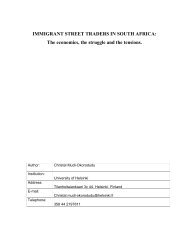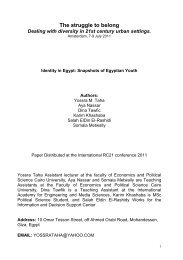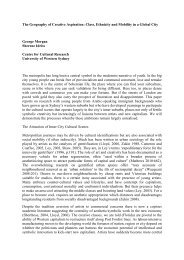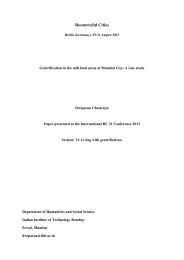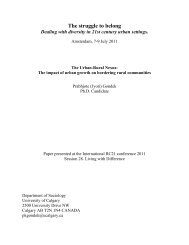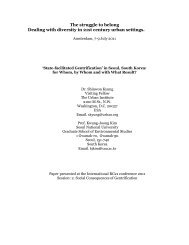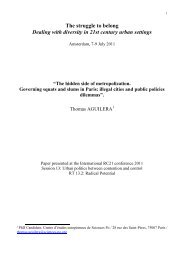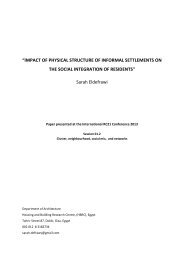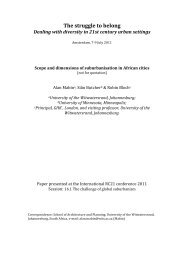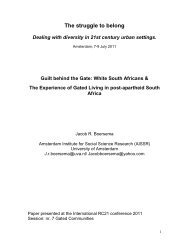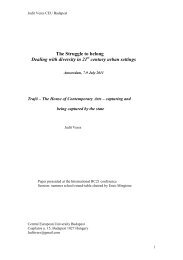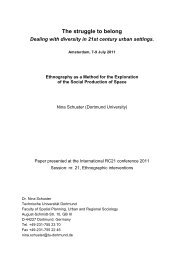Fragmentation as a threat to social cohesion - RC21 ORG ...
Fragmentation as a threat to social cohesion - RC21 ORG ...
Fragmentation as a threat to social cohesion - RC21 ORG ...
You also want an ePaper? Increase the reach of your titles
YUMPU automatically turns print PDFs into web optimized ePapers that Google loves.
may distinguish between two kinds of <strong>social</strong> production of the favela: a “materialist<br />
production” and a “discursive production”. In their dialectic reciprocity they are<br />
essential <strong>to</strong> understand the production of the “fragmented city”.<br />
4.1 The materialist production of the Favela <strong>as</strong> “informal city”<br />
What we call the materialist production of space is the result of two production<br />
patterns: the “perceived” and “conceived” space, according <strong>to</strong> the terminology of<br />
Henri Lefebvre (2004 [1974]). Everyday practice, conceptual thoughts, images and<br />
perceptions of space are inscribed in<strong>to</strong> this kind of space, which is perceived then<br />
mostly <strong>as</strong> “naturalized” urban form. It is the production of the favela which appears in<br />
all its “otherness” compared <strong>to</strong> the notion of a formal city.<br />
Favel<strong>as</strong> are often <strong>as</strong>sociated with the „disorderly city“, a stigma that goes back <strong>to</strong> the<br />
illegal status of their initial emergence <strong>as</strong> informal settlements. The first favel<strong>as</strong> were<br />
created more than 100 years ago. For a long time, they eluded administrative<br />
planning. Generally, legal issues like land ownership have been settled in the<br />
meantime. Favel<strong>as</strong> are often incorrectly referred <strong>to</strong> <strong>as</strong> “slums”. However, they are<br />
neither slum are<strong>as</strong>, nor are they marked by disorganized, makeshift housing, but<br />
rather residential are<strong>as</strong> with permanent buildings, the homes of large parts of Brazil’s<br />
urban undercl<strong>as</strong>s. Due <strong>to</strong> low incomes, their residents do not have access <strong>to</strong> the<br />
housing market of the “proper” city.<br />
Favel<strong>as</strong> are considered informal urban settlements – in spite of the “formal” city<br />
depending on the services provided by favela residents. The urban undercl<strong>as</strong>s is<br />
used and accepted <strong>as</strong> an army of cheap labour. They clean homes, cook or guard<br />
office buildings and homes of the middle and upper cl<strong>as</strong>ses. Most of the favela<br />
dwellers spend more time in the residential are<strong>as</strong> of the rich, than in their own<br />
homes. By means of their work force, they incorporate the connections between<br />
these different <strong>social</strong> and socio-economic realities. They are physically present,<br />
though <strong>social</strong>ly excluded from that world, concerning their rights and chances in life.<br />
Further, they work in construction, do carrier services or are street vendors and<br />
thereby keep the urban economy going. The Brazilian geographer Mil<strong>to</strong>n San<strong>to</strong>s<br />
(2004) characterizes this <strong>as</strong> a “bipolarization without dualism” (“bipolarizacao, m<strong>as</strong><br />
nao dualismo”). He divides the city in developing countries viewing their economic<br />
activity in two interacting and interdependent circuits with different logics: the favela,<br />
<strong>as</strong> the urban space of poverty, thus represents the inferior circuit of the city. It faces<br />
and interacts with the superior circuit. From an economic point of view, the favel<strong>as</strong><br />
and their residents are thus fully (even if <strong>as</strong>ymmetrically) integrated in<strong>to</strong> urban<br />
society and urban economy. However, these vital parts of urban society are<br />
marginalized in terms of rights and <strong>social</strong> acceptance. 1<br />
The status of <strong>social</strong> acceptance of the favel<strong>as</strong> and their dwellers is reflected in the<br />
political and governmental attention. The political organization of space changed over<br />
the l<strong>as</strong>t decades from a policy of ignorance <strong>to</strong> a policy of acceptance. These policies<br />
relate <strong>to</strong> different strategies of control: Where<strong>as</strong> the former consisted of controlling by<br />
undoing (in the worst c<strong>as</strong>e by clearance), the current consists of active control<br />
strategies in combination with improvement strategies. Governmental and nongovernmental<br />
initiatives are slowly incre<strong>as</strong>ing <strong>to</strong> improve the living conditions in<br />
favel<strong>as</strong>. Even though favel<strong>as</strong> are no longer seen only <strong>as</strong> a problem, but also <strong>as</strong> a<br />
potential for urban society, they still are spaces of poverty (Valladares 2002, 214)<br />
1<br />
For a discussion of the term 'marginality' see Perlman 1976, 2006<br />
8 Deffner, Hoerning: <strong>Fragmentation</strong> <strong>as</strong> a Threat <strong>to</strong> Social Cohesion?



